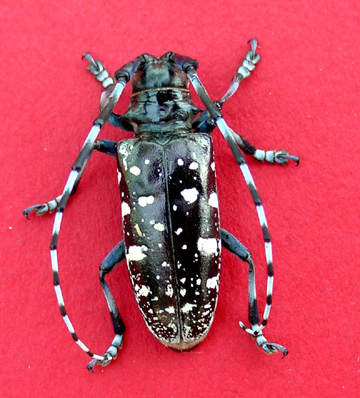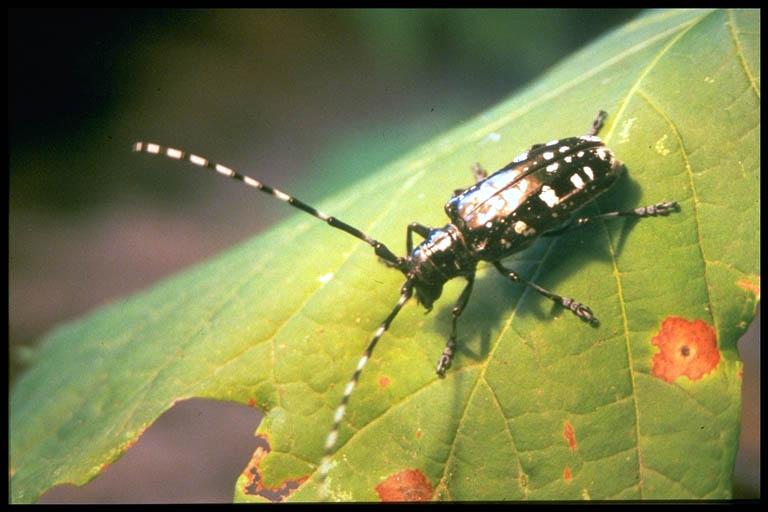Common
Name:
Asian
Longhorned Beetle 
Scientific Name: Anoplophora
glabripennis
Classification:
Phylum or
Division: Arthropoda
Class:
Insecta
Order:
Coleoptera
Family:
Cerambycidae
Identification::
The Asian Longhorned Beetle (ALB) is large, ranging from 0.75-1.25
inches long;
with very long black and white antennae. The body is glossy
black
with irregular white spots. These beetles feed on many
species of
hardwood trees. Adults can be seen from late spring to fall depending
on the
climate. Predominant reproductive cycle is one year, passing the winter
most
commonly in the larval stage. Adult emergence in New
York
and Illinois
appears to range from July to November. The
female ALB chews depressions (oviposition
sites) in the bark of trees to lay eggs. A single female beetle can lie
from 35
to 90 eggs. Hatching within 10 to 15 days, the worm–like immature
larvae tunnel
under tree bark and bore into healthy hardwood trees. The beetle larvae
feed on
living tree tissue during the fall and winter and, after pupating,
emerge
through exit holes during the spring. After emerging, adult beetles
feed on
tree exteriors for 2 to 3 days, then mate. Adult beetles remain active
only
during summer and early fall months before perishing—completing a
1–year life
cycle. Since beetle larvae live deep inside trees the majority of the
year,
they can easily and unknowingly be moved in firewood, live trees, or
fallen
timber. ALB more commonly spread by natural means; under their own
power they
can fly distances greater than 400 yards. Migration may also depend on
the
abundance of suitable host materials (i.e., hardwood trees).
Original Distribution: Eastern
China
in poplar
plantations and other plantings
Current Distribution: it
was first found
infesting trees in the Greenpoint section of Brooklyn,
New
York
in
August 1996. It is believed that ALB entered the U.S.
in wood pallets holding pipe shipped from China
for a sewer project in the late 1980s. In
September 1996 an infestation was also found in Amityville,
NY,
several miles east of the Greenpoint
infestation. It is thought that this infestation occurred as
a
result of movement of infested wood from Greenpoint
Site and Date of Introduction:
As of February 2001,
ALB has been found infesting trees in only two cities in the U.S.;
New
York
and Chicago.
However, a Carteret,
New
Jersey,
homeowner discovered ALB on a tree in his back
yard on August
2, 2004.
A
large infestation was found in nearby area, spreading into Woodbridge,
New
Jersey,
and Rahway,
New
Jersey.
The beetle was first spotted in Jersey
City
in October of 2002 by someone who saw it fly
onto a tree. A later news report attracted his attention to the
potential
threat of the Asian longhorned beetle. He contacted the NJDA, and state
and
federal agricultural inspectors confirmed the beetle's presence soon
after.
Based on an initial survey, it appears that approximately 100 trees
were
affected within a 9-acre area just north of the Newport
Parkway
and just east of Washington
Boulevard, New
Jersey.
Moreover, live beetles have been found at the ports and in warehouses
in
several different states.
Mode(s) of Introduction:
Determined by USDA
officials to have entered the United States inside solid wood packing
material
from China.
Reason(s) Why it has Become Established:
Because the ALB has
an extended egg-through-larval transition, the organism remains
virtually invisible for up to one year. During this period it is difficult to
detect and
may be easily inadvertently transported by human activity especially in
wood
packing materials. Once delivered to a potential colonization site in
the
temperate zone or North
America,
a ready supply of
host arboreal species is virtually guaranteed. Although, subject to
heightened
levels of awareness on the part of government and citizenry the long
“hidden”
passage of the beetle to adult renders detection difficult, except by
means of
identifying egg deposit borings or emergent adults. ALB has no known
natural
predator in the United
States
for any phase of the life cycle; only limited biotic and abiotic
factors have been identified within the temperate zone of North
America
to limit the potential
invisible for up to one year. During this period it is difficult to
detect and
may be easily inadvertently transported by human activity especially in
wood
packing materials. Once delivered to a potential colonization site in
the
temperate zone or North
America,
a ready supply of
host arboreal species is virtually guaranteed. Although, subject to
heightened
levels of awareness on the part of government and citizenry the long
“hidden”
passage of the beetle to adult renders detection difficult, except by
means of
identifying egg deposit borings or emergent adults. ALB has no known
natural
predator in the United
States
for any phase of the life cycle; only limited biotic and abiotic
factors have been identified within the temperate zone of North
America
to limit the potential
Ecological
Role: ALB
is considered a
pest both here and in China,
its country of origin. The beetle attacks many different species of
hardwood
trees, including maple (Norway,
sugar, silver, and red), birch, horse chestnut, poplar, willow, elm,
ash, and black locust. Unlike most cerambycids inhabiting the temperate
zone,
the ALB feeds on both healthy and weakened trees as opposed to recently
dead or
dying wood. In addition, unlike most wood-feeding insects, inhabiting
living
hosts the ALB is polyphagous as opposed to monophagous, feeding on a
wide
variety of host species. . Females
oviposit at multiple locations from exposed roots to the trunks and all
but the
smallest branches of the host trees allowing a high concentration of
infestation of a single host organism. ALB larvae devour healthy bark
and
xylum, creating tunnels into the healthy tree which begin horizontally
and turn
upwards to a length of approximately 10 cm. In great numbers this
destruction
of the healthy heartwood of the tree first weakens the host organism
and with
continued or repeated infestation can lead to its demise
Benefit(s):
Although
there are
currently no documented benefits of this species, it is hard to imagine
potential for positive effects offsetting the potential negative impact
of this
species on North American trees. Typical cerambycids, infesting dying
or
recently dead wood contribute to the natural “recycling process”,
breaking down
potential wood sources for other organisms and contributing to soil
creation
and enrichment. However, it is difficult to construe the destruction of
healthy
living organisms positively integrated with established ecosystems as
anything
but negative.
Threat(s):
The
ALB has the potential
to cause more damage than Dutch elm disease, chestnut blight, and gypsy
moths
combined, destroying millions of acres of America’s
treasured hardwoods, including national
forests and backyard trees. The beetle has the potential to damage such
industries as lumber, maple syrup, nursery, commercial fruit, and
tourism
accumulating over $41 billion in losses.
Control
Level Diagnosis:
Highest
priority, ALB has the potential to
alter North American Ecosystems, due to its tree killing and
polyphagous habits
and potential for widespread distribution on the continent
Control
Method: At
this time, the
only accepted official means of dealing with trees having any signs of
ALB in
the US
is to cut down all infested trees, chip and burn all of the wood, and
grind the stump. As of January 2001, over 5,000 trees have been removed
in the New
York
area, and almost 1,500 in Chicago.
Although treatments exist to control
ALB–infested cargo, the ALB is not easily controlled once it is
introduced into
the environment. Because the majority of the beetle’s life is spent
deep within
the heartwood
of host
trees, it is difficult to control using contact insecticides. Although
costly
and undesirable, the only assured method of eliminating the beetle is
to cut
and chip or burn infested trees and replace them with nonhost species.
The recently introduced insecticide imidacloprid shows
great potential
in
preventing the spread of ALB and is expected to become an additional
effective
control tool in the eradication of this pest. Imidacloprid is a
systemic
insecticide that, when applied directly into the trunk of a tree or the
soil
near a tree, moves quickly upward into stems, twigs, and foliage where
the
beetles would be expected to feed and lay eggs.

 invisible for up to one year. During this period it is difficult to
detect and
may be easily inadvertently transported by human activity especially in
wood
packing materials. Once delivered to a potential colonization site in
the
temperate zone or
invisible for up to one year. During this period it is difficult to
detect and
may be easily inadvertently transported by human activity especially in
wood
packing materials. Once delivered to a potential colonization site in
the
temperate zone or